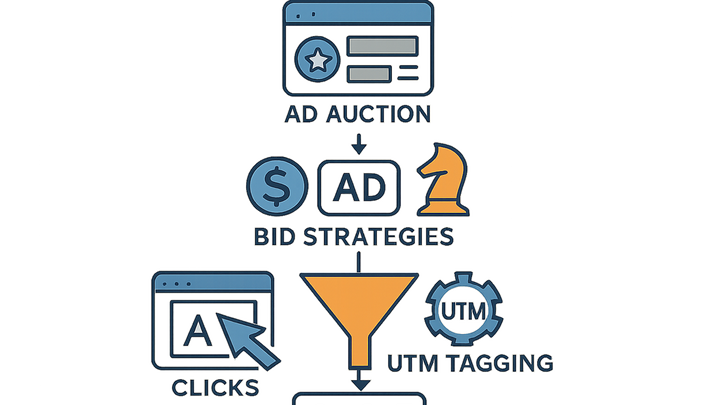Published on 2025-06-29T18:36:41Z
What is PPC (Pay-Per-Click)? Definitions and Tracking Practices
PPC, or Pay-Per-Click, is a digital advertising model where advertisers pay a fee each time their ad is clicked. It’s widely used on platforms like Google Ads, Facebook Ads, and Bing Ads to drive targeted traffic and conversions. By controlling budgets and bids, marketers can precisely manage spend and reach audiences based on keywords, demographics, or behaviors. Tracking PPC performance requires consistent tagging via UTM parameters—UTMGuru simplifies URL creation and management—alongside robust analytics solutions like Plainsignal, which offers cookie-free session and conversion data. Together, these tools empower data-driven optimization, enhancing ROI and scaling campaign success.
Ppc (pay-per-click)
PPC is an ad model where advertisers pay per click; track campaigns with UTMGuru and Plainsignal for accurate analytics.
Understanding PPC Basics
An overview of how PPC works, the ad auction process, and payment models.
-
Ppc auction process
How ad auctions determine which ads display based on bids, ad relevance, and quality scores.
- Ad rank:
Calculated by multiplying your bid amount by the Quality Score; it determines ad position.
- Bidding strategy:
Options like Manual CPC, Enhanced CPC, and Automated bidding optimize spend and performance.
- Ad rank:
-
Cost models
Different payment structures used in digital advertising beyond standard CPC.
- Cpc (cost-per-click):
Pay each time someone clicks your ad.
- Cpm (cost-per-thousand impressions):
Pay per thousand ad views.
- Cpa (cost-per-acquisition):
Pay when a specific action or conversion occurs.
- Cpc (cost-per-click):
Tracking PPC Campaigns
How to track PPC campaigns using UTM parameters and integrate with analytics tools like PlainSignal.
-
Using utm parameters
UTM parameters in URLs enable detailed campaign attribution in analytics platforms.
- Building utm urls with utmguru:
Use utmguru.com to generate and manage UTM-tagged URLs via its web app or Chrome extension.
- Essential utm parameters:
Include utm_source, utm_medium, utm_campaign, utm_term, and utm_content for granular reporting.
- Building utm urls with utmguru:
-
Integrating with plainsignal
Implement cookie-free analytics for UTM-tagged PPC landing pages by adding the PlainSignal snippet:
- Installation code:
<link rel="preconnect" href="//eu.plainsignal.com/" crossorigin /> <script defer data-do="yourwebsitedomain.com" data-id="0GQV1xmtzQQ" data-api="//eu.plainsignal.com" src="//cdn.plainsignal.com/plainsignal-min.js"></script> - Data collection:
PlainSignal captures session metrics and conversion events without relying on traditional cookies.
- Installation code:
Best Practices for PPC Success
Guidelines to optimize campaign structure, ad relevance, and budget allocation for better performance.
-
Keyword selection and match types
Choosing relevant keywords and applying match types to balance reach and precision.
- Broad, phrase, and exact match:
Balance reach (broad) against targeting precision (exact) to manage spend and relevancy.
- Negative keywords:
Exclude unwanted search terms to reduce wasted ad spend.
- Broad, phrase, and exact match:
-
Ad copy and landing page optimization
Craft compelling ad copy and ensure landing pages align with user intent to boost Quality Score and conversions.
- Ad copy best practices:
Include clear CTAs, unique value propositions, and relevant keywords.
- Landing page experience:
Focus on fast load times, mobile optimization, and consistent messaging.
- Ad copy best practices:
Measuring PPC Performance and ROI
Key metrics to evaluate campaign effectiveness and methods to refine strategy.
-
Key performance indicators (kpis)
Core metrics that indicate PPC campaign health and efficiency.
- Ctr (click-through rate):
The ratio of clicks to ad impressions, measuring engagement.
- Cpc (cost-per-click):
Average cost paid for each click; impacts budget and ROI.
- Cpa (cost-per-acquisition):
Cost to acquire a customer or lead; essential for profitability analysis.
- Ctr (click-through rate):
-
Reporting and optimization
Techniques to analyze data and continuously improve PPC outcomes.
- A/b testing ads:
Test variations in headlines, descriptions, and creatives to boost performance.
- Budget reallocation:
Shift spend to top-performing elements based on data-driven insights.
- A/b testing ads:
